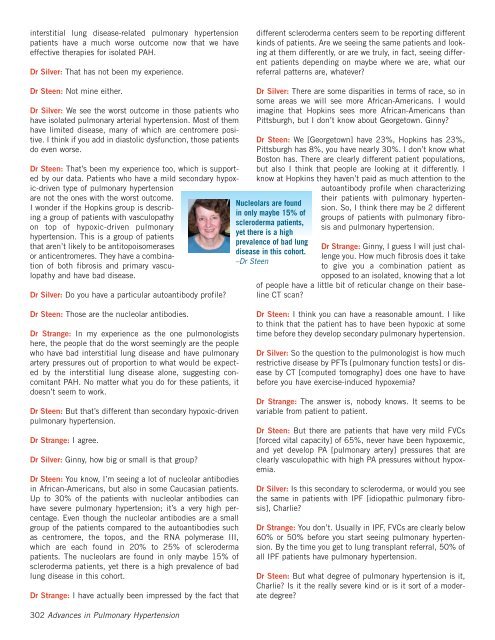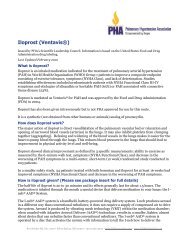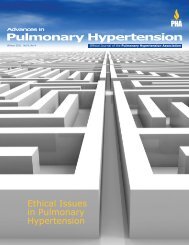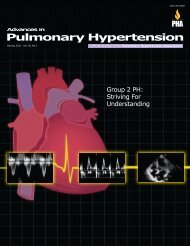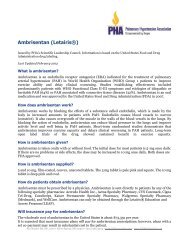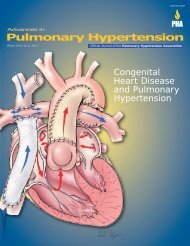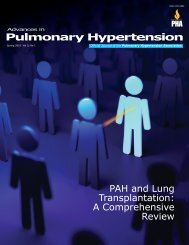Pulmonary Hypertension - PHA Online University
Pulmonary Hypertension - PHA Online University
Pulmonary Hypertension - PHA Online University
Create successful ePaper yourself
Turn your PDF publications into a flip-book with our unique Google optimized e-Paper software.
interstitial lung disease-related pulmonary hypertensionpatients have a much worse outcome now that we haveeffective therapies for isolated PAH.Dr Silver: That has not been my experience.different scleroderma centers seem to be reporting differentkinds of patients. Are we seeing the same patients and lookingat them differently, or are we truly, in fact, seeing differentpatients depending on maybe where we are, what ourreferral patterns are, whatever?Dr Steen: Not mine either.Dr Silver: We see the worst outcome in those patients whohave isolated pulmonary arterial hypertension. Most of themhave limited disease, many of which are centromere positive.I think if you add in diastolic dysfunction, those patientsdo even worse.Dr Steen: That’s been my experience too, which is supportedby our data. Patients who have a mild secondary hypoxic-driventype of pulmonary hypertensionare not the ones with the worst outcome.I wonder if the Hopkins group is describinga group of patients with vasculopathyon top of hypoxic-driven pulmonaryhypertension. This is a group of patientsthat aren’t likely to be antitopoisomerasesor anticentromeres. They have a combinationof both fibrosis and primary vasculopathyand have bad disease.Dr Silver: Do you have a particular autoantibody profile?Dr Silver: There are some disparities in terms of race, so insome areas we will see more African-Americans. I wouldimagine that Hopkins sees more African-Americans thanPittsburgh, but I don’t know about Georgetown. Ginny?Dr Steen: We [Georgetown] have 23%, Hopkins has 23%,Pittsburgh has 8%, you have nearly 30%. I don’t know whatBoston has. There are clearly different patient populations,but also I think that people are looking at it differently. Iknow at Hopkins they haven’t paid as much attention to theautoantibody profile when characterizingNucleolars are foundin only maybe 15% ofscleroderma patients,yet there is a highprevalence of bad lungdisease in this cohort.–Dr Steentheir patients with pulmonary hypertension.So, I think there may be 2 differentgroups of patients with pulmonary fibrosisand pulmonary hypertension.Dr Strange: Ginny, I guess I will just challengeyou. How much fibrosis does it taketo give you a combination patient asopposed to an isolated, knowing that a lotof people have a little bit of reticular change on their baselineCT scan?Dr Steen: Those are the nucleolar antibodies.Dr Strange: In my experience as the one pulmonologistshere, the people that do the worst seemingly are the peoplewho have bad interstitial lung disease and have pulmonaryartery pressures out of proportion to what would be expectedby the interstitial lung disease alone, suggesting concomitantPAH. No matter what you do for these patients, itdoesn’t seem to work.Dr Steen: But that’s different than secondary hypoxic-drivenpulmonary hypertension.Dr Strange: I agree.Dr Silver: Ginny, how big or small is that group?Dr Steen: You know, I’m seeing a lot of nucleolar antibodiesin African-Americans, but also in some Caucasian patients.Up to 30% of the patients with nucleolar antibodies canhave severe pulmonary hypertension; it’s a very high percentage.Even though the nucleolar antibodies are a smallgroup of the patients compared to the autoantibodies suchas centromere, the topos, and the RNA polymerase III,which are each found in 20% to 25% of sclerodermapatients. The nucleolars are found in only maybe 15% ofscleroderma patients, yet there is a high prevalence of badlung disease in this cohort.Dr Strange: I have actually been impressed by the fact thatDr Steen: I think you can have a reasonable amount. I liketo think that the patient has to have been hypoxic at sometime before they develop secondary pulmonary hypertension.Dr Silver: So the question to the pulmonologist is how muchrestrictive disease by PFTs [pulmonary function tests] or diseaseby CT [computed tomography] does one have to havebefore you have exercise-induced hypoxemia?Dr Strange: The answer is, nobody knows. It seems to bevariable from patient to patient.Dr Steen: But there are patients that have very mild FVCs[forced vital capacity] of 65%, never have been hypoxemic,and yet develop PA [pulmonary artery] pressures that areclearly vasculopathic with high PA pressures without hypoxemia.Dr Silver: Is this secondary to scleroderma, or would you seethe same in patients with IPF [idiopathic pulmonary fibrosis],Charlie?Dr Strange: You don’t. Usually in IPF, FVCs are clearly below60% or 50% before you start seeing pulmonary hypertension.By the time you get to lung transplant referral, 50% ofall IPF patients have pulmonary hypertension.Dr Steen: But what degree of pulmonary hypertension is it,Charlie? Is it the really severe kind or is it sort of a moderatedegree?302 Advances in <strong>Pulmonary</strong> <strong>Hypertension</strong>


